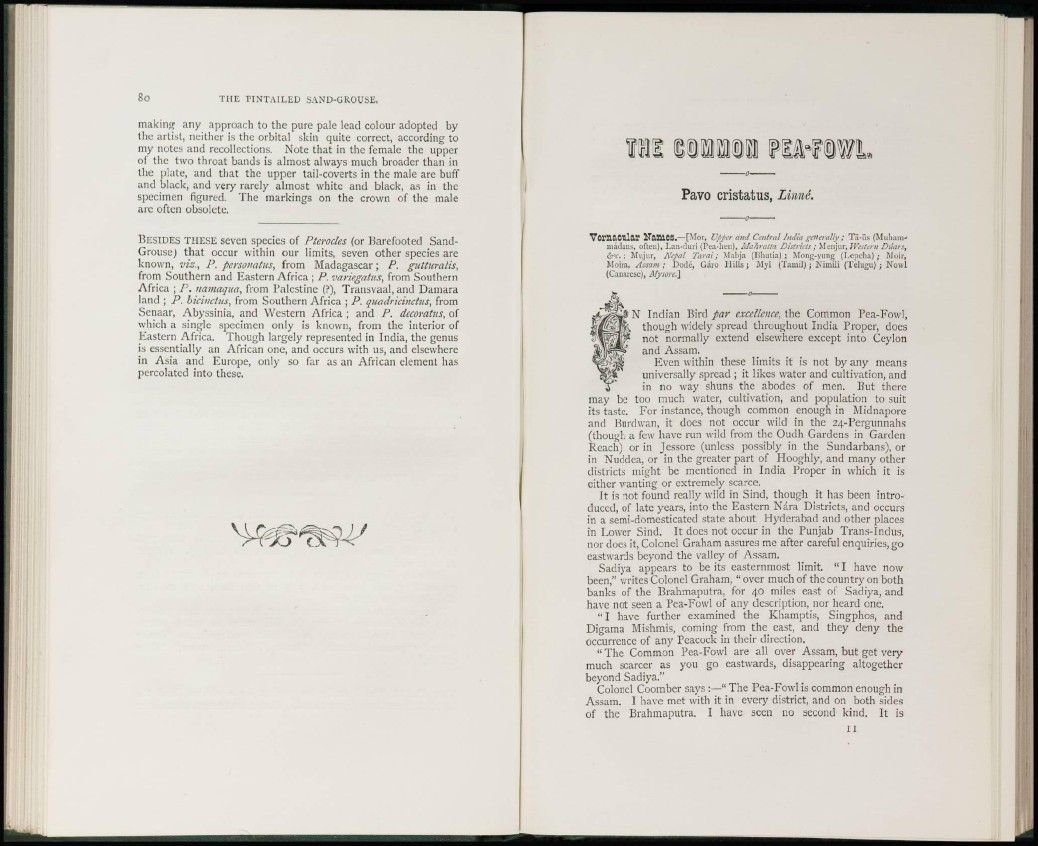
So THE TINTAILED SAND-GROUSE.
making any approach to t h e pure pale lead colour adopted by
the artist, neither is the orbital skin quite correct, according to
my notes and recollections. Note that in t h e female the upper
of the two throat bands is almost always much broader than in
the plate, and that the upper tail-coverts in the male are buff
and black, and very rarely almost white and black, as in the
specimen figured. The markings on the crown of the male
are often obsolete.
BESIDES THESE seven species of Pterocles (or Barefooted Sand-
Grouse) that occur within our limits, seven other species are
known, via., P. personatits, from Madagascar; P. gutturalis,
from Southern and Eastern Africa ; P. variegatus, from Southern
Africa ; P. tiamaqua, from Palestine (?), Transvaal, and Damara
land ; P. bicinctus, from Southern Africa ; P. quadricinctns, from
Senaar, Abyssinia, and Western Africa ; and P. decoratus, of
which a single specimen only is known, from the interior of
Eastern Africa. Though largely represented in India, t h e genus
is essentially an African one, and occurs with us, and elsewhere
in Asia and Europe, only so far as an African clement has
percolated into these.
Pavo cristatus, Linné.
Vernacular Names.—[Mor, Upper and Central India generally; Ta-üs (Muliammádans,
often), Lan-duri (Pea-hen), Mahratta Districts; Menjur, Western Dúars,
6r=c. ; Mujur, Nepal Tarai; Mabja (Bhutia) ; Mong-yung (Lepcha); Moir,
Moira, Assam ; Dodé, Gáro H i l l s ; Myl (Tamil) : Nimili (Telugu) : Nowl
(Canarese), Mysore,]
N Indian Bird pay excellence, t h e Common Pea-Fowl,
though widely spread throughout India Proper, does
not normally extend elsewhere except into Ceylon
and Assam.
Even within these limits it is not by a n y means
universally spread ; it likes water and cultivation, and
in no way shuns the abodes of men. But there
may be too much water, cultivation, and population to suit
its taste. For instance, though common enough in Midnapore
and Burdwan, it does not occur wild in the 24-Pergunnahs
(though a few have run wild from the Oudh Gardens in Garden
Reach) or in Jessore (unless possibly in t h e Sundarbans), or
in Nuddca, or in the greater part of Hooghly, and many other
districts might be mentioned in India Proper in which it is
either wanting or extremely scarce.
I t is not found really wild in Sind, though it has been introduced,
of late years, into the Eastern Nara Districts, and occurs
in a semi-domesticated state about Hyderabad and other places
in Lower Sind. It does not occur in the Punjab Trans-Indus,
nor does it, Colonel Graham assures me after careful enquiries, go
eastwards beyond the valley of Assam.
Sadiya appears to be its easternmost limit. " I have now
been," writes Colonel Graham, " over much of t h e country on both
banks of the Brahmaputra, for 40 miles east of Sadiya, a nd
have not seen a Pea-Fowl of any description, nor heard one.
" I have further examined the Khamptis, Singphos, and
Digama Mishmis, coming from the east, and they deny the
occurrence of any Peacock in their direction.
" The Common Pea-Fowl are all over Assam, but get very
much scarcer as you go eastwards, disappearing altogether
beyond Sadiya."
Colonel Coomber says :—" The Pea-Fowl is common enough in
Assam. I have met with it in every district, and on both sides
of the Brahmaputra. I have seen no second kind. It is